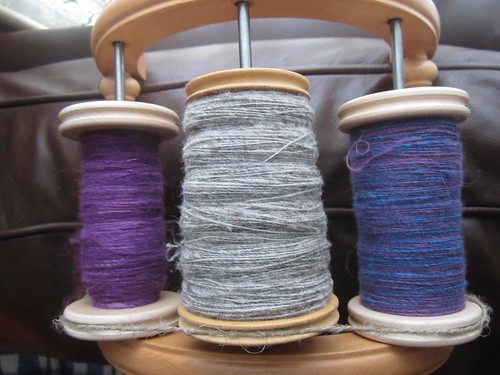My work tends to get the most attention when it’s bright and loud and saturated with color. I know in most cases, that’s what the Tiny Dino Studios brand is known for. I also happen to really love working with natural fibers and fibers from different breeds. Knowing there different fleece characteristics across different breeds and then actually exploring some of those differences for myself are two very different things.
I have my comfort zone wools for spinning, Falkland in any form, and Merino I like, but as long as it’s not top (because I am picky.) Alpaca is fun and different. And just generic American Wool is fun and durable and soft. This is what I spin most often because it’s what the people around me produce or sell, so it’s easy to come by. But I have been trying to branch out a bit.
I’ve been working through some Cormo, which is lovely to spin. It’s soft, but not so soft it doesn’t have any durability. It’s my favorite parts of Corriedale with the best parts of Merino thrown in. Then, I received my Tunis roving back from the mill. Tunis is a little coarser, and you can feel the difference between a mediumwool sheep and a finewool sheep when you hold a skein of Cormo in one hand and a skein of Tunis in the other. And yet, they are both soft. Perhaps it’s just the way I spun it (worsted, chain-plied, heavy fingering weight) but I can hold it up to my neck and it doesn’t prickle. And though it has less crimp than the Cormo, the Tunis feels distinctly springy–like it’s got the energy to paint the town red while the Cormo wants to eat bon-bons while reclining on a silk settee.
The color is vastly different as well. Tunis is known as a red sheep, and while the wool is not actually red, it has a peachy, kind of antiqued white color to it.

It’s hard to see on it’s own. In this photo (which is too bright, I will give you) the skein just kind of looks to me like a skein of springy undyed wool.
But when you sit it next to the Cormo, you can really see the difference.

The Tunis is on the left. The Cormo is on the right. Please study carefully, there will be an exam.
Then, I received this in the mail yesterday:

That is a lock of Rambouillet. I purchased a 10 oz bag on Etsy last week and it is gorgeous. As you can tell from the veg matter in the photo, this lock is unwashed–unwashed! Look how gorgeously white and crimpy that is! I am very excited. This is possibly the softest lock I have held in my hand ever. And the locks were so beautiful, I couldn’t quite bring myself to break them up by throwing them in a big tub to soak.

To keep the lock integrity as much as possible, I am using the Yarn Harlot’s method for stove top wool washing.
Updates when it’s clean!














